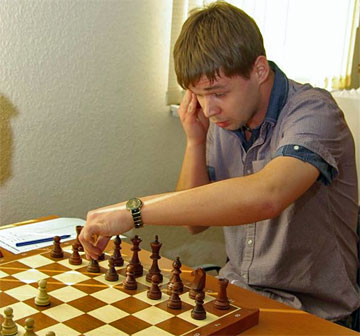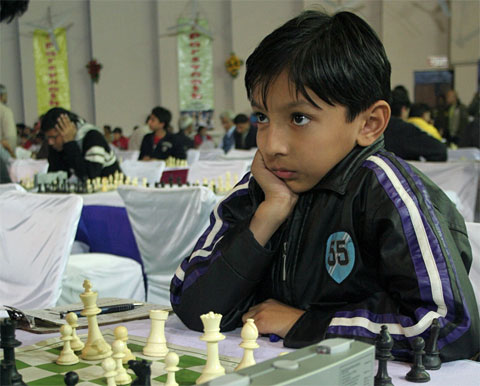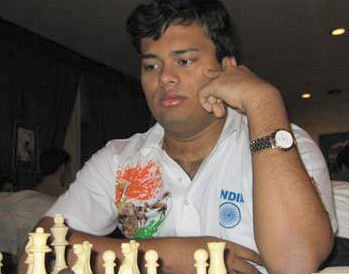| Latest | Greatest | Lobby | Journals | Search | Options | Help | Login |
|
|
|
This topic is archived. |
| Home » Discuss » Topic Forums » Sports |
|
| Jack Rabbit
|
Sat Jan-10-09 02:36 PM Original message |
| The Jack Rabbit Chess Report (January 10): Youngsters Shine in Stockholm |
|
Wojtaszek and Bogner Share First in Stockholm
 Grandmaster Radoslaw Wojtaszek of Poland, who turns 22 Tuesday, and German IM Sebastian Bogner, who turns 18 next Saturday, shared first place with with 7 points each out of nine rounds in the 38th annual Rilton Cup completed Monday in Stockholm. Wojtaszek was given the trophy based on a superior tie break score. He also won last's years Rilton. Another young grandmaster, David Berces of Hungary, who turned 18 Thursday, tied for third place with Yuriy Kuzubov of Ukraine, Evgeny Gleizerov of Russia and Pia Cramling of Sweden with 6� points each. Seventy-two players participated in this year's event. Kurnosov Wins Hastings  Igor Kurnosov of Russia won the masters' tournament at the annual Hastings Chess Congress with 7� points Monday in nine rounds. The only player with a chance to catch Kurnosov was defending co-champion Valery Neverov of Ukraine, who needed a victory over Kurnosov when the two clashed in the final round. The game ended in a draw. Neverov, who had taken or shared first place in the three previous editions of the Hastings, tied for second with Swedish GM Emanuel Berg with 7 points. The Hastings Chess Congress is one of the oldest tournaments on the international circuit. A great tournament was held at Hastings, site of Norman conquest, in 1895. That event was attended by most of the top players of the day, including then-world champion Dr. Emanuel Lasker, his predecessor, Wilhelm Steinitz, Dr. Siegbert Tarrasch, the leading theortician of the day and Mikhail Chigorin, a two-time challenger to the world championship. However, the event was won by Harry Nelson Pillsbury, a young American playing in his first international tournament. Starting in December 1920 an annual premier tournament was held at Hastings, sometimes cited as the Hastings Christmas Tournament. This was a round-robin event among the top players of the day and was won by such luminaries as Jos� Capablanca, Alexander Alekhine and Salo Flohr. Despite losing much of its luster after World War II, the premier tournament continued until 2002-03. The last winner of the premier was Danish GM Peter Heine Nielsen. Since then, the main attraction has been the Swiss system event, the masters' tournament. Chorus Begins January 16; JRCR will return the weekend of January 23  The annual Corus Chess Tournament begins January 16 and runs through February 1. In addition to the elite Group A, this year's Corus is going to feature one of the strongest B and C Groups ever. The Jack Rabbit Chess Report will return in two weeks with coverage of the Corus Chess Tournament. Calendar Corus Chess Tournament, Wijk aan Zee 16 January-1 February. Gibraltar Chess Festival 27 January-5 February. Moscow Open 30 January-9 February. Aeroflot Open, Moscow 16-27 February. Topalov-Kamsky World Championship Semifinal Match, Sofia 16-28 February. Eight Rounds. Winner will challenge Anand for the world championship. Linares Grandmaaster Tournament 18 February-8 March. Cappelle la Grande Open 28 February-7 March. Reykjavik Open 4-13 March. European Individual Championships, Budva (Montenegro) 5-19 March. Foxwoods Open, Mashantucket, Connecticut April 8-12. MTel Masters, Sofia May 9-19. Aerosvit International Tournament, Foros (Ukraine) June 9-20. |
| Printer Friendly | Permalink | | Top |
| Jack Rabbit
|
Sat Jan-10-09 02:38 PM Response to Original message |
| 1. This week's games |
|
Your humble hare acknowledges the assistance of Fritz 6.0 on analysis. Diagrams on the Jack Rabbit Chess Report are made with Chess M�rida, a true type font that can be downlaoded free here. !""""""""# $tMvWlVmT% $OoOoOoOo% $ + + + +% $+ + + + % $ + + + +% $+ + + + % $pPpPpPpP% $RnBqKbNr% /(((((((() WHITE White to move (This position is a theoretical draw) |
| Printer Friendly | Permalink | | Top |
| Jack Rabbit
|
Sat Jan-10-09 02:51 PM Response to Reply #1 |
| 2. Almasi - Ni Hua, Round 8, Reggio Emilia |
|
Ni Hua won the 51st annual Torneo di Capadanno in Reggio Emilia, Italy by a point and a half over his nearest rival.
 Ni Hua Zoltan Almasi - Ni Hua Torneo di Capadanno, Round 8 Reggio Emilia, 3 January 2009 Open Sicilian Game: Sveshnikov Defense (Chelyabinsk Opening) 1.e4 c5 2.Nf3 Nc6 3.d4 cxd4 4.Nxd4 Nf6 5.Nc3 e5 6.Ndb5 d6 7.Bg5
7...a6 8.Na3 b5 9.Bxf6
9...gxf6 10.Nd5 f5
11.Bd3
11...Be6 12.c3
12...Bg7
13.Nxb5
13...axb5 14.Bxb5 Bd7 15.exf5
15...Nb8 16.Qg4
16...0-0!?
17.0-0
!""""""""# $tM W Tl+% $+ +v+oVo% $ + O + +% $+b+nOp+ % $ + + +q+% $+ P + + % $pP + PpP% $R + +rK % /(((((((() WHITE: Zoltan Almasi Position after 17.0-0 17...h5
18.Qf3 e4?!
19.Qxe4 Re8 20.Qd3 Bxb5 21.Qxb5 Nd7 22.Rfd1!?
22...Rb8!
23.Qa6 Rxb2
24.Rab1?!
24...Rxb1 25.Rxb1 Nf6 !""""""""# $ + Wt+l+% $+ + +oV % $q+ O M +% $+ +n+p+o% $ + + + +% $+ P + + % $p+ + PpP% $+r+ + K % /(((((((() WHITE: Zoltan Almasi Position after 25...Nd7f6 26.Qd3
26...Nxd5 27.Qxd5 Re5
28.Qd3 Qf6 29.g3 Qxf5 30.Qxf5 Rxf5 31.Rd1 Bf8
32.c4 Ra5 33.Rd5
33...Rxd5
34.cxd5 Be7 35.a4 Bd8!
36.f4!?
36...f5!
37.h3?!
37...Kf7 38.Kf2 Kg6!?
39.Ke2?
!""""""""# $ + V + +% $+ + + + % $ + O +l+% $+ +p+o+ % $p+ + P O% $+ + + Pp% $ + +k+ +% $+ + + + % /(((((((() WHITE: Zoltan Almasi Position after 39.Kf2e2 39...h4!
40.g4
40...fxg4 41.hxg4 Ba5 0-1
|
| Printer Friendly | Permalink | | Top |
| Jack Rabbit
|
Sat Jan-10-09 02:53 PM Response to Reply #1 |
| 3. Wojtaszek - Hillarp Persson, Round 5, Stockholm |
 Radoslaw Wojtaszek Radoslaw Wojtaszek - Tiger Hillarp Persson Rilton Cup, Round 5 Stockholm, 31 December 2008 Semi-Slav Queen's Gambit: Stoltz Opening 1.d4 d5 2.c4 c6 3.Nf3 Nf6 4.Nc3 e6 5.e3 Nbd7 6.Qc2 Bd6 7.b3
7...0-0 8.Bb2
8...Re8
9.Be2 dxc4
10.bxc4 e5 11.0-0 exd4
12.exd4 Nf8 13.Rfe1
13...Bg4 14.Rad1
14...Ne6!?
15.h3?!
15...Bh5?!
16.Nh4
16...Bxe2 17.Nxe2
17...Bb4 18.Rf1 Nh5
19.Nf3 Nef4 20.Nxf4
20...Nxf4 21.Qf5
21...Ne2+ 22.Kh1 Qc8 23.Qc2
23...Nf4 24.Ng5 Ng6
25.f4
25...h6 26.f5 Nh4 !""""""""# $t+w+t+l+% $Oo+ +oO % $ +o+ + O% $+ + +PN % $ VpP + M% $+ + + +p% $pBq+ +p+% $+ +r+r+k% /(((((((() WHITE: Radoslaw Wojtaszek Position after 25...Ng6h4 27.Nxf7!?
27...Kxf7 28.c5
28...Qd8?
29.d5! cxd5
30.f6 Re4
!""""""""# $t+ W + +% $Oo+ +lO % $ + + P O% $+ Po+ + % $ b +t+ M% $+ + + +p% $pBq+ +p+% $+ +r+r+k% /(((((((() WHITE: Radoslaw Wojtaszek Position after 30...Re8e4 31.fxg7+!
31...Kg8 32.Rf8+ Qxf8 33.gxf8Q+ Rxf8 34.Qb3
34...Nf5
35.Rxd5 Kh7
36.Rd7+ Kg6
37.Qf3
37...Re1+ 38.Kh2 h5
39.Rg7+ Nxg7 40.Qxf8 Ne6 41.Qf6+ Kh7 42.Qf7+ Kh6 43.Bc1+ 1-0
|
| Printer Friendly | Permalink | | Top |
| Jack Rabbit
|
Sat Jan-10-09 02:55 PM Response to Reply #1 |
| 4. Kuzubov - Bogner, Round 8, Stockholm |
|
Perhaps we should watch young Herr Bogner this year.
 Sebastian Bogner Yuriy Kuzubov - Sebastian Bogner Rilton Cup, Round 8 Stockholm, 4 January 2009 Slav Queen's Gambit: Tikhi Opening 1.d4 d5 2.c4 c6 3.Nf3 Nf6 4.e3 a6 5.Qc2 e6 6.Nbd2
6...Nbd7 7.b3 Be7
8.Bd3 0-0!?
9.0-0
9...h6
10.Bb2 c5
11.Rad1 b6 12.e4 dxe4 13.Nxe4 Qc7
14.dxc5
14...bxc5 15.Qe2 Bb7 16.Ng3
16...Rad8 17.Bb1
17...Rfe8 18.Rfe1 Qc6 19.Bc3 Nf8
20.Bxf6
20...Bxf6 21.Be4 Qc7 22.Bxb7 Qxb7 23.Nh5!?
23...Bc3
!""""""""# $ + Ttml+% $+w+ +oO % $o+ +o+ O% $+ O + +n% $ +p+ + +% $+pV +n+ % $p+ +qPpP% $+ +rR K % /(((((((() WHITE: Yuriy Kuzubov Position after 23...Bf6c3 24.Rxd8 Rxd8 25.Rc1 Bd4
26.Nxd4 cxd4 27.Nf4 Qc7
28.Nd3 Ng6 29.Qe4
29...Ne7
30.b4 Qd7 31.h3
31...Ng6?
!""""""""# $ + T +l+% $+ +w+oO % $o+ +o+mO% $+ + + + % $ PpOq+ +% $+ +n+ +p% $p+ + Pp+% $+ R + K % /(((((((() WHITE: Yuriy Kuzubov Position after 31...Ne7g6 32.c5!
32...f5 33.Qf3 Qc7
34.a4 Qc8
35.c6 e5!?
36.c7!
36...Rd6 37.Rc6?
37...Nh4!
38.Rxd6
!""""""""# $ +w+ +l+% $+ P + O % $o+ R + O% $+ + Oo+ % $pP O + M% $+ +n+q+p% $ + + Pp+% $+ + + K % /(((((((() WHITE: Yuriy Kuzubov Position after 38.Rc6d6:R 38...Nxf3+!!
39.gxf3 Qxc7
40.Rd5 e4 41.fxe4
41...fxe4 42.Nc5 e3
43.Rxd4 Qe5! 0-1
|
| Printer Friendly | Permalink | | Top |
| Jack Rabbit
|
Sat Jan-10-09 02:56 PM Response to Reply #1 |
| 5. Howell - Kurnosov, Round 7, Hastings |
 Igor Kurnosov David Howell - Igor Kurnosov Chess Congress, Masters' Tournament, Round 7 Hastings, 3 January 2009 Italian Royal Game: Neo-Classical Defense (Clam Opening) (Giucco Pianisimo) 1.e4 e5 2.Nf3 Nc6 3.Bc4 Bc5 4.c3 Nf6 5.d3
5...d6 6.Bb3 a6 7.h3 Be6
8.Bc2!?
!""""""""# $t+ Wl+ T% $+oO +oOo% $o+mOvM +% $+ V O + % $ + +p+ +% $+ Pp+n+p% $pPb+ Pp+% $RnBqK +r% /(((((((() WHITE: David Howell Position after 8.Bb3c2 8...d5!
9.Nbd2 0-0 10.Qe2 Qe7
11.Nf1!?
11...b5
12.Ng3
12...Rad8
13.Bg5
13...h6 14.Bh4
14...d4
15.0-0 g6 16.Kh1?
16...Kh7 !""""""""# $ + T T +% $+ O Wo+l% $o+m+vMoO% $+oV O + % $ + Op+ B% $+ Pp+nNp% $pP +qPp+% $R + +r+k% /(((((((() WHITE: David Howell Position after 16...Kg8h7 17.Nxe5
17...Nxe5 18.f4 Ned7 19.Qf3
19...Qe8 20.e5 Bd5 21.Qf2 !""""""""# $ + TwT +% $+ Om+o+l% $o+ + MoO% $+oVvP + % $ + O P B% $+ Pp+ Np% $pPb+ Qp+% $T + +r+k% /(((((((() WHITE: David Howell Position after 21.Qf3f2 21...Qe6!
22.Ne4 Bxe4 23.dxe4 d3!
24.Qf3 dxc2 25.exf6 Rfe8 26.e5 Nb6 27.Rac1
27...Nc4 28.Rfe1 Rd2
29.Re2 Red8 30.Rxc2 R2d3
31.Qg4 Rd1+ 32.Re1
32...Rxe1+ 33.Bxe1 Qxg4 34.hxg4 Ne3
35.Re2 Nxg4 36.g3 g5 37.b4
37...Bb6 38.f5 Re8 39.e6 Nxf6 40.c4 fxe6 41.c5 Bxc5! 0-1
|
| Printer Friendly | Permalink | | Top |
| Jack Rabbit
|
Sat Jan-10-09 02:58 PM Response to Reply #1 |
| 6. Neverov - Williams, Round 4, Hastings |
 Valery Neverov Valery Neverov - Simon Williams Chess Congress, Masters' Tournament, Round 4 Hastings, 31 December 2008 West India Game: King's Indian Defense (Kramer Opening) 1.d4 Nf6 2.c4 g6 3.Nc3 Bg7 4.e4 d6 5.Nge2
5...a6
6.Ng3 h5
7.Be2 c6 8.a4
8...a5 9.0-0 h4!?
10.Nh1 e5
11.Be3 Nbd7 12.f4 Qb6 13.fxe5
13...dxe5 14.c5 Qb4?!
!""""""""# $t+v+l+ T% $+o+m+oV % $ +o+ Mo+% $O P O + % $pW Pp+ O% $+ N B + % $ P +b+pP% $R +q+rKn% /(((((((() WHITE: Valery Neverov Position after 14...Qb6b4 15.Nf2 Bh6?
16.Bxh6 Rxh6 17.dxe5!
17...Nxe5 18.Qd6!
18...Nfd7
!""""""""# $t+v+l+ +% $+o+m+o+ % $ +oQ +oT% $O P M + % $pW +p+ O% $+ N + + % $ P +bNpP% $R + +rK % /(((((((() WHITE: Valery Neverov Position after 18...Nf6d7 19.Nb5!!
19...cxb5 20.Bxb5!
20...Rh5
21.Rad1 Ra6 22.Qc7 Ra8 23.Ng4
23...Kf8 24.Nxe5 Rxe5
25.Rxd7 Bxd7 26.Qxe5 Bxb5
27.Qh8+ Ke7 28.Qf6+ 1-0
|
| Printer Friendly | Permalink | | Top |
| Jack Rabbit
|
Sun Jan-11-09 12:00 PM Response to Original message |
| 7. Nine-year-old defeats grandmaster in tournament play |
|
Edited on Sun Jan-11-09 12:06 PM by Jack Rabbit
From the Hindustan Times via Susan Polgar's blogspot
Dated Sunday, January 11 Hetul makes history after upsetting Kazakh GM Press Trust Of India New Delhi, January 11, 2009 Nine-year old Hetul Shah made history in the first round of the 7th Parsvnath International Open chess tournament defeating Grandmaster Nurlan Ibrayev of Kazakhstan, in New Delhi on Sunday. Shah betterd Parimarjan Negi's record of being the youngest Indian to beat a GM by more than a year. Negi was 11 years old when he beat Grandmaster Ivan Nemet in the Biel Open in 2004. The first round also turned out well for other Indians with six-time national champion Surya Sekhar Ganguly, Negi, GMs Abhijit Kunte and Dibyendu Barua starting with victories. Ganguly, who lead the Indian contingent, made short work of compatriot Niraj Saripalli while Kunte got past DK Chopra and Barua defeated Dinesh Kumar Gupta. Read more at the link. Perhaps Hetul is another youngster we need to keep an eye on. |
| Printer Friendly | Permalink | | Top |
| Jack Rabbit
|
Tue Jan-13-09 02:09 PM Response to Reply #7 |
| 8. Ibrayev - Hetul, Round 1, New Delhi |
|
David and Goliath
 Nine-year-old Hetul Shah Nurlan Ibrayev - Hetul Shah 7th Parsvnath International Open, Round 1 New Delhi, 11 January 2009 Spanish Grand Royal Game: Chigorin Defense 1.e4 e5 2.Nf3 Nc6 3.Bb5 a6 4.Ba4 Nf6 5.0-0 Be7 6.Re1 b5 7.Bb3 d6 8.c3 0-0 9.h3 Na5
10.Bc2 c5 11.d4 Qc7 12.Nbd2 cxd4 13.cxd4 Bd7
14.Nf1 Rfc8
15.Ne3 Nc6 16.a3 Bf8
17.b3?!
!""""""""# $t+t+ Vl+% $+ Wv+oOo% $o+mO + +% $+o+ O + % $ + Pp+ +% $Pp+ Nn+p% $ +b+ Pp+% $R BqR K % /(((((((() WHITE: Nurlan Ibrayev Position after 17.b2b3 17...Nxd4!!
18.Nxd4 Qc3 19.Ne2!?
19...Qxa1
20.Qd2
20...d5 21.b4?
!""""""""# $t+t+ Vl+% $+ +v+oOo% $o+ + M +% $+o+oO + % $ P +p+ +% $P + N +p% $ +bQnPp+% $W B R K % /(((((((() WHITE: Nurlan Ibrayev Position after 21.b3b4 21...d4!
22.Nd1 Rxc2!?
23.Qxc2 Rc8 24.Qd2 Nxe4 25.Qd3 Nd6 26.Bb2 Qa2
27.f4 Qc4 28.Qb1
28...d3 29.Ne3 Qe4 30.Nc3 Qxf4 31.Ncd5
31...Qg3 32.Nf1 Qg6 33.Bxe5 Nc4 34.Nf4
34...Qb6+ 35.Kh1 Nxe5 36.Rxe5 Bd6 37.Re4 Bc6 38.Qc1
38...Qb7
39.Re1 !""""""""# $ +t+ +l+% $+w+ +oOo% $o+vV + +% $+o+ + + % $ P + N +% $P +o+ +p% $ + + +p+% $+ Q R + % /(((((((() WHITE: Nurlan Ibrayev Position after 39.Re4e1 39...Bxg2+!!
40.Nxg2 Rxc1 41.Rxc1 Bf4
42.Rc3 d2 43.Rd3 h6 44.Kg1 Qb6+ 0-1
|
| Printer Friendly | Permalink | | Top |
| nickgutierrez
|
Thu Jan-15-09 08:31 PM Response to Original message |
| 9. Have we had any indication of who's playing at Linares? n/t |
| Printer Friendly | Permalink | | Top |
| Jack Rabbit
|
Sat Jan-17-09 08:10 PM Response to Reply #9 |
| 10. Linares 2009 |
|
Source: Chessdom.com
February 18-March 8, 2009 Viswanathan Anand, Magnus Carlsen, Vassily Ivanchuk, Levon Aronian, Teimour Radjabov, Wang Yue, Alexander Grischuk and Lenier Dominguez. |
| Printer Friendly | Permalink | | Top |
| Jack Rabbit
|
Sun Jan-18-09 08:01 PM Response to Original message |
| 11. Update (Sunday January 18): Ganguly Leads in New Delhi with One Round Remaining |
|
Indian grandmaster Surya Shekhar Ganguly is setting the pace after nine rounds of the ten-round 7th Parsvnath International Open in New Delhi with 8 points.
Ganguly took over first place by himself today by defeating fellow Indian grandmaster Dibeyandu Barua in 79 moves. Kazakh grandmaster Peter Kostenko and GM Mikhail Ulibin of Russia, who started the day tied with Ganguly for first place with 7 points each, drew against each other to drop to a tie for second. The last round will be played in New Delhi tomorrow morning at 10 am (Sunday 8:30 pm PST) and can be viewed live by following the link to live games at the tournament website. |
| Printer Friendly | Permalink | | Top |
| Jack Rabbit
|
Sun Jan-18-09 08:04 PM Response to Reply #11 |
| 12. Endgame: Ganguly-Kostenko, Round 8, New Delhi |
|
This is a very instructive Rook vs. Knight and pawn(s) ending.
 Surya Shekhar Ganguly Surya Shekhar Ganguly - Petr Kostenko 7th Parsvnath International Open, Round 8 New Delhi, 17 January 2009 According to Fine (Basic Chess Endings), in Rook vs. Knight and pawn endings the Rule is:
In the following game, Black never has three pawns for the exchange, but for the most part has two. He almost pulls out a draw, but a timely sacrifice prevents him from getting his King close to the pawns. We pick up the game at White's 36th move, just following a series of exchanges and before it comes down to Knight and pawns against a Rook. As of now, Black has two pawns for a Bishop. !""""""""# $ + + + L% $+ + + +o% $o+ + T +% $+ + O N % $ + O + +% $BpO M + % $ +p+ + P% $+ +r+ +k% /(((((((() WHITE: Surya Shekhar Ganguly Position after 35...Rc6f6:R 36.Rg1 Kg8?
37.Nf3+ Kf7 38.Nxe5+ Ke6 39.Ng4 Nxc2
40.Nxf6 Kxf6 41.Bc5
41...Ke5 !""""""""# $ + + + +% $+ + + +o% $o+ + + +% $+ B L + % $ + O + +% $+pO + + % $ +m+ + P% $+ + + Rk% /(((((((() WHITE: Surya Shekhar Ganguly Position after 41...Kf6e5 42.Kg2!
42...Kd5 43.Be7 Ke4 44.Kf2 Ne3
45.Bc5 Kd3
!""""""""# $ + + + +% $+ + + +o% $o+ + + +% $+ B + + % $ + O + +% $+pOlM + % $ + + K P% $+ + + R % /(((((((() WHITE: Surya Shekhar Ganguly Position after 45...Ke4d3 46.Bxd4!!
46...Kxd4 47.Ke2!
47...Ke4 48.Rg8 Nd5 49.Re8+ Kd4 50.Rh8 Nf4+
51.Kd1 Kd3 !""""""""# $ + + + R% $+ + + +o% $o+ + + +% $+ + + + % $ + + M +% $+pOl+ + % $ + + + P% $+ +k+ + % /(((((((() WHITE: Surya Shekhar Ganguly Position after 51...Kd4d3 52.Rd8+!
52...Ke4 53.Kc2 Kf3 54.Kxc3 Kg2 55.Rd6 h5 56.h4
56...Kg3 57.Rxa6 Kxh4 58.Kd4
58...Kg3 59.Ke4 h4
60.Ra8 Ng2 61.b4 h3 62.Ra3+
62...Kg4 63.b5 h2 64.Ra1 Nf4 65.Rh1
65...Ne2
66.Kd3 Nf4+ 67.Ke4 Ne2 68.Kd3
68...Nf4+ 69.Kd2 Kg3 70.b6 1-0
|
| Printer Friendly | Permalink | | Top |
| Jack Rabbit
|
Sun Jan-18-09 08:13 PM Response to Reply #11 |
| 13. Negi - Kostenko, Round 7, New Delhi |
|
Petr Kostenko, a minor grandmaster from Kazakhstan, moved into first place clear with this fine victory over the young Indian prodigy, Parimarjan Negi.
 Petr Kostenko Parimarjan Negi - Petr Kostenko 7th Parsvnath International Open, Round 7 New Delhi, 16 January 2009 Closed French Game: Nimzovich Defense (Winawer Defense) 1.e4 e6 2.d4 d5 3.Nc3 Bb4
4.e5 c5 5.Qg4
5...Ne7 6.dxc5
6...Nbc6 7.Bd2 Ng6
8.Nf3
8...Bxc5 9.Bd3 Qc7!?
10.0-0-0
10...a6 11.h4 Bd7 12.Bxg6
12...hxg6 13.Qf4 f6 14.Nxd5
14...exd5 15.e6 0-0-0
16.exd7+ Qxd7 17.Qg3
17.Qg3 Qf5 18.Rdf1 Rhe8 19.Qh3?!
19...Qxh3
20.gxh3?
!""""""""# $ +l+t+ T% $+o+ + O % $o+m+ Oo+% $+ Vo+ + % $ + + + P% $+ + +n+p% $pPpB P +% $+ K +r+r% /(((((((() WHITE: Parimarjan Negi Position after 20.gh3:Q 20...Re4!
21.Rhg1 Ne7 22.Rg4 Kd7 23.Bc3
23...Ke8 24.Re1
24...Rxe1+ 25.Bxe1 Kf7 26.Bb4
!""""""""# $ + + + T% $+o+ Mlo % $o+ + Oo+% $+ Vo+ + % $ B + +rP% $+ + +n+p% $pPp+ P +% $+ K + + % /(((((((() WHITE: Parimarjan Negi Position after 26.Be1b4 26...Bxf2
27.Bxe7 Kxe7 28.Rxg6 Kf7 29.Rg4 Re8
30.Kd2 Bc5 31.c3 Re4
32.b3 b5 33.a4
33...bxa4 34.bxa4 Re3
35.Rf4 g6 36.c4
!""""""""# $ + + + +% $+ + +l+ % $o+ + Oo+% $+ Vo+ + % $p+p+ R P% $+ + Tn+p% $ + K + +% $+ + + + % /(((((((() WHITE: Parimarjan Negi Position after 36.c3c4 36...Ra3!
37.Ne5+ Kg7 38.Nd3 Ra2+ 39.Ke1
39...Be3 40.Rf3 Bd2+ 41.Kd1
41...dxc4 42.Nc5 Bb4
43.Ne6+ Kf7 44.Nd8+ Ke8 45.Nc6 Bc5
46.a5
46...Kd7 47.Rxf6 c3!?
48.Ne5+
48...Ke7 49.Rc6 Rd2+
50.Ke1
50...Bf2+ 51.Kf1 Bd4 52.Nxg6+ Kd7 53.Rc4 c2 0-1
|
| Printer Friendly | Permalink | | Top |
| Jack Rabbit
|
Mon Jan-19-09 03:04 PM Response to Original message |
| 14. Update (Tuesday January 19): Ganguly, Ulibin tie in New Delhi; Wijk aan Zee underway |
|
Ganguly, Ulibin Share First Prize in New Delhi
 Surya Shekhar Ganguly with the first prize trophy Indian grandmaster Surya Shekhar Ganguly and GM Mikhail Ulibin finished in a tie for first place at the conclusion of the tenth and final round of the 7th Parsvnath International Open today with 8� points each in New Delhi. Ganguly-ji was awarded the tournament championship based on superior tie-break points. The Indian GM entered today's activity alone in first place, needing only a draw to secure a share of the top prize. Ganguly played Indian IM P Karthikeyan to a 15-move draw while Uliban, who entered today a half point behind Ganguly, defeated M. S. Thejkumar, an untitled Indian player, in 42 moves to catch Ganguly in the standings. Grandmaster Petr Kostenko of Kazakhstan, who drew his final game against Indian GM Neeloptal Das, finished third with 8 points. Corus Tournament Begins in Wijk aan Zee  Five players are tied for first place in the A Group with 2 points each after three rounds in the annual Corus Chess Tournament, one of the premier annual events in the sport, in the Dutch seaside resort of Wijk aan Zee as of today. The five are Sergei Karjakin (Ukraine), Gata Kamsky (United States), reigning Dutch national champion Jan Smeets, Teimour Radjabov (Azerbaijan) and Sergei Movsesian (Slovakia). In the B Group, former FIDE Knock Out champion Rustam Kasimdzhanov, former world title challenger Nigel Short of Britain and Czech GM David Navara are tied for first place with 2� points each. Group C finds Venezuelan GM Eduardo Iturrizaga and Dutch IM Manuel Bosboom tied for first with 2� points each. The fourth round of each of the three events begins tomorrow at 13:30 CET (4:30 am PST) and will be broadcast live on the official tournament website. The website Chessdom.com will broadcast three games to be determined later today with commentary. |
| Printer Friendly | Permalink | | Top |
| DU
AdBot (1000+ posts) |
Tue Apr 23rd 2024, 07:34 PM Response to Original message |
| Advertisements [?] |
| Top |
| Home » Discuss » Topic Forums » Sports |
|
Powered by DCForum+ Version 1.1 Copyright 1997-2002 DCScripts.com
Software has been extensively modified by the DU administrators
Important Notices: By participating on this discussion board, visitors agree to abide by the rules outlined on our Rules page. Messages posted on the Democratic Underground Discussion Forums are the opinions of the individuals who post them, and do not necessarily represent the opinions of Democratic Underground, LLC.
Home | Discussion Forums | Journals | Store | Donate
About DU | Contact Us | Privacy Policy
Got a message for Democratic Underground? Click here to send us a message.
© 2001 - 2011 Democratic Underground, LLC